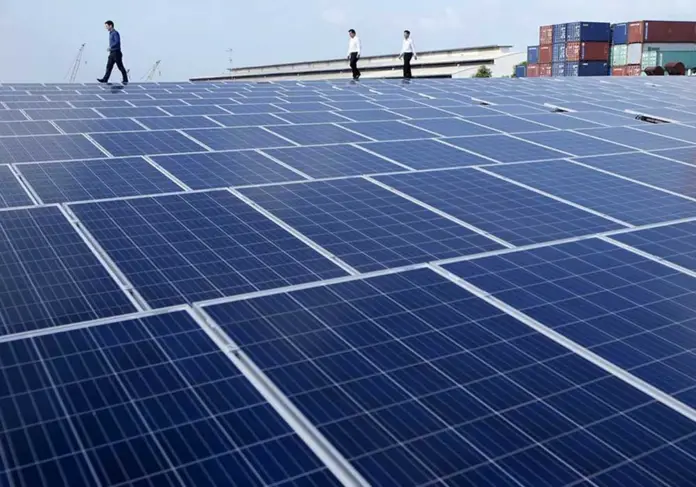There are two types of energy: renewable and non-renewable. Non-renewable energy includes the resources from coal, gas and oil. They are made by burning fossil fuels to create energy. Renewable energy, often referred to as clean energy, comes from natural resources or processes that are constantly replenished. The renewable energy sources are solar energy, wind energy, hydropower, geothermal energy, and biomass energy.
Renewable energy sources make up to 26% of the world’s electricity today, but according to the International Electricity Agency, IEA its share is expected to reach more than 30% by 2024. Overall, renewable electricity is predicted to grow by 1200 GW by 2024 all over the world, which is equivalent of the total electricity generation capacity of the USA.
According to data compiled by the US Energy Information Administration, there are seven countries already at, or very near to 100 percent renewable power: Iceland (100 percent), Paraguay (100), Costa Rica (99), Norway (98.5), Austria (80), Brazil (75), and Denmark (69.4). The main renewables in these countries are hydropower, wind, geothermal, and solar.
Bloomberg New Energy Finance (BNEF) has projected that by 2040, Germany’s grid will see nearly 75 percent renewable penetration, Mexico will be over 80 percent, and Brazil and Italy will be over 95 percent. BNEF was not looking at what could theoretically happen by mid-century if countries pushed as hard as required by the Paris Climate Accord. They were just looking at business as usual over the next two decades.
After the emergence of Pakistan on the world’s map, in the decades of 60s and 70s, the hydropower generation projects were constructed and electricity on cheaper rates was provided to the nation. These projects included Warsak, Mangla and Tarbela hydropower projects. Because of the cheaper electricity available in that era, the industry of Pakistan was on the rise. Hydropower is considered to be the cheapest form of the power generation then and today. In the decades of 80s and 90s, our governments introduced new power generation policy in private sector because of which the IPPs were introduced for thermal power generation. Under these contracts with IPPs, very expensive power generation projects were built, which caused the price of electricity to rise sky high. Today, the situation in the country is that more than 60% of the total generation capacity is generated from thermal projects in which more than 50% generation is by IPPs while about 10% is by the public sector. Only about 25% of the total generation capacity is hydropower and the remaining 10 to 15 percent comes from solar, wind, nuclear and other resources.
The developed and many developing countries around the world are now turning to renewable energy; hydropower, solar power and wind power projects are at the forefront. The benefits of renewable energy are enormous. This type of power generation doesn’t harm the environment and is called the Green Energy while thermal power generation makes the environment very much polluted.
In the past, solar and wind power projects used to cost a lot and the unit price of electricity generated from those projects was very high. But over the time, the cost of all the machinery of such projects, the cost of construction, installation and operating these projects has decreased significantly and will gradually go on decreasing in the coming days.
If we talk about the previous solar power project, Quaid-e-Azam Solar Park, built in 2014-15, which had a capacity of 100 MW, but it is generating only 18 to 25 megawatts of electricity, and power generation was also quite expensive. The project is generating electricity at a rate of about Rs24 per unit. Similarly, the past wind power projects generating electricity at very high tariffs and it costs around Rs20 to 22 per unit.
With the passage of time, the cost of solar and wind power projects has come down significantly and the electricity generated from them is now around Rs6 to Rs8 per unit.
In the last five to seven years, there has been a lot of innovation in solar power generation. Now many countries around the world have started building floating solar panels that can be installed on the water lakes of large dams. There are many benefits of such floating solar panels projects, out of which four major benefits are as follows:
1. These solar panels are installed on the surface of water lakes and thus the places in the plain flat areas can be used for many other purposes.
2. For hydropower generated from dams, there is already a complete system of powerhouses and transmission lines, which can be used for floating solar panels power generation with minor modifications, and a complete new system may not be needed.
3. Water for cleaning and maintenance of solar panels will also be available from the same water lakes and the cost of importing water from other places will also be significantly reduced.
4. The process of evaporation of water from the dam lakes will be greatly slowed down due to the installation of solar panels on the surface of the lakes and the heat of the sun will not reach the water and thus water will not be wasted from large reservoirs. This saved water can generate more electricity and can also be utilized for more irrigation.
The use of floating solar panels is growing rapidly worldwide. Such projects are being implemented in all developed and many developing countries because these projects have many advantages and will provide extremely affordable electricity to the consumers, in the future. Since China has a large number of dams and the big water lakes of such dams can be used for flouting solar panel projects. The world’s largest floating solar panels project is also under construction in China. By 2030, China will be able to get more than 10% of its total electricity generation capacity from such projects.
The United States is also not far behind in its plans for floating solar panels projects and such projects are constructed on a very fast speed. There were only seven projects till 2017 and by 2019 the number has increased to more than 100, while in 2020 about 70 more such projects have been started. According to a report on US Solar Energy, the United States will also be able to generate about 10 percent of its total electricity generation from such projects in the next few years.
There is also a lot of focus on floating solar panels in all European countries, with more than 50 projects currently under construction in the UK alone, and the number is expected to grow rapidly in the near future. Similar projects have been launched in Germany, France, Italy and many other countries.
Pakistan can also generate very cheap electricity by launching this new technology –floating solar panels projects – while Pakistan has huge water lakes in form of Tarbela Dam’s water lake having a surface area of about 250 square kilometers, and Mangla Dam’s water lake having a surface area of about 260 square kilometers. Pakistan can also obtain the above benefits by implementing such projects at the surface of these water lakes. Apart from these two large dam lakes, Pakistan also has many other small to medium sized dam lakes on which such projects can be implemented. As a result, a large area of Pakistan’s plains where future solar panels projects are planned to be installed could be used for other useful purposes.
The Pakistan Meteorological Department (PMD) conducted a study in 2013 entitled ‘Wind Power Potential Survey of Coastal Areas of Pakistan’, which the Ministry of Science & Technology provided funding for. This study enabled PMD to identify potential “wind corridors” where economically feasible wind farms could be established. The Gharo-Jhimpir wind corridor in Sindh was identified as the most lucrative site for wind power plants. The wind power potential covered an area of about 9700 square km with a gross wind power potential of 43000 MW. Similarly, near the Pakistan, Iran and Afghanistan borders in Balochistan, there is a big wind corridor, which can be developed in future. There is another one in Swat, KP which can also be developed in future if needed.
As per Alternative Electricity Development board, AEDB, at present, 24 wind power projects of 1235.20 MW cumulative capacity have achieved Commercial Operation and are supplying electricity to National Grid while 12 wind power projects of 610 MW capacity are under construction.
Six solar power projects of 430 MW capacity are operational while four IPPs with a cumulative capacity of 41.80 MW are in the process of achieving financial closing of their projects and other 12 Solar PV power projects of 419 MW cumulative capacity are at different stages of project development.
Still with over half of the rural population unable to access electricity, Pakistan is rightfully undertaking a major build-out of electricity generation capacity to meet demand growth into the future. Further adoption of ever-cheaper and accessible renewable energy can make a greater contribution towards meeting Pakistan’s growing electricity demands. Instead, Pakistan is currently on an energy pathway towards over-reliance on imported fossil fuels and out-dated coal technology.
The Institute for Energy Economics and Financial Analysis (IEEFA) of Pakistan has modelled a high level, alternative future for Pakistan’s electricity system that addresses cost burdens and energy security.
In IEEFA’s model, renewables like wind and solar power will supply 28% of Pakistan’s increasing electricity requirements by 2030. Generation costs would be reduced and energy security increased through a diversity of generation technologies roughly split 30:30:30:10 between renewable energy through wind and solar, thermal power, hydro power, and nuclear power.
Pakistan needs to focus on projects that provide us with the cheapest electricity. Pakistan cannot afford expensive electricity i.e. thermal power. All our industries need cheaper electricity so that they can flourish and our GDP growth can be improved along with the increase in exports. In the future, the cheaper electricity can only come from renewable energy projects. Therefore, our present and future governments shall have to focus only on renewable energy projects, i.e. hydropower, solar power and wind power, so that Pakistan can get out of its energy troubles in the next five to 10 years.







